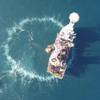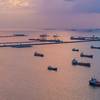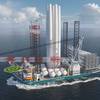The car ferry Venus, which recently entered traffic, is the Swedish Road Administration’s most modern ferry and the first in a series with a distinct environmental profile. The propulsion engines onboard are modern Volvo Penta
low-emission engines equipped with catalytic converters and particle filters.
The high efficiency of the engines results in low fuel consumption and good performance.
The Road Administration’s ferry unit, with slightly more than 60 ships, is Sweden’s largest shipping company measured in number of vessels. The Road Administration has overall responsibility in Sweden for the environmental impact of road traffic and as part of this, the ferry company is working for a better environment, primarily through reduced exhaust emission.
“We want to be the leaders in the environmental field and we are well below the standards set by the IMO (International Maritime Organization),” says Mikael von Zweigbergk, technical director at the Road Administration’s ferry company. “We have equipped the new ferry, Venus, with modern, low emission engines with a catalytic converter and particle filter. We have ordered another ferry similar to this one, which will be delivered in the spring, and we have an option on two more.”
Modern engines and catalytic converters
The engines onboard are four 12-liter Volvo Penta D12Ds at 450 hp each. The D12D in its initial design has very low exhaust emissions due to highly advanced and entirely electronically controlled fuel system. The emission levels for the D12D are well below the limits set by the IMO and will also meet the extensive standards that will become effective in the US during 2004. The generator plant onboard is powered by two Volvo Penta D5A TA units at 72 kW each.
To further reduce exhaust emissions, the engines onboard the Venus are equipped with catalytic converters that reduce the level of hydrocarbons and carbon monoxide by 80 to 90%. Moreover, the propulsion engines are equipped with particle filters that separate 90% of the particles and continually combust them into carbon dioxide and water.
Exceptionally good performance
The Volvo Penta D12 is developed for marine requirements, with adapted torque and power curves.
“One of our demands for the engines was the torque at low rpms, since it is very important for performance and to be able to maneuver the ferry safely. The Volvo Penta D12 engine has such power that we can operate the ferry at cruise speed on just two engines, which saves fuel,” relates Mikael von Zweigbergk.
The four propulsion engines work in pairs and each is connected to a thruster through drive belts and couplings, one at each end of the ferry, which can be driven in either direction. The entire drive system is controlled and supervised electronically and each engine is used optimally.
“The control system continually measures the load on each engine. If the load is low, only one engine is used and if both engines are driving, the system ensures that each engine carries exactly the same load and that they work at the same rpm. This minimizes the load on the drive belts and couplings and optimizes power for maneuvering,” says Christian Johansson, project leader from Marine Commercial Center within Volvo Penta Region Europe.
Sponsored Content
Solar shades of exceptional quality

Subscribe for
Maritime Reporter E-News
Maritime Reporter E-News is the maritime industry's largest circulation and most authoritative ENews Service, delivered to your Email five times per week









